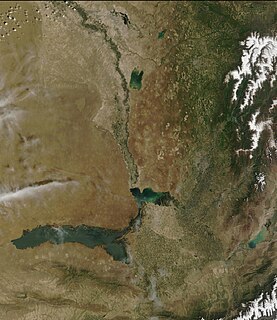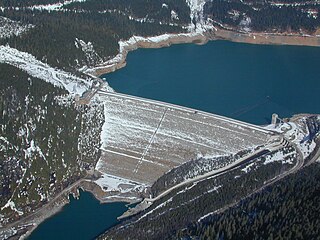
The Dez Dam, formerly known as Mohammad Reza Shah Pahlavi Dam before 1979 Revolution, is an arch dam on the Dez River in the southwestern province of Khuzestan, Iran. It is about 22 km (14 mi) north east of Andimeshk. It was built between 1959 and 1963 under the rule of Mohammad Reza Pahlavi, the last Shah of Iran, with contacting an Italian consortium and is owned by the Khuzestan Water & Power Authority. The dam is 203 metres (666 ft) high, making it one of the highest in the country, and has a reservoir capacity of 3,340,000,000 m3 (2,710,000 acre⋅ft). At the time of construction the Dez Dam was Iran's biggest development project. The primary purpose of the dam is hydroelectric power production and irrigation. It has an associated 520 MW power station and its reservoir helps irrigate up to 80,500 ha of farmland. US$42 million of the cost to construct the dam came from the World Bank.

Kaptai Dam is on the Karnaphuli River at Kaptai, 65 kilometres (40 mi) upstream from Chittagong in Rangamati District, Bangladesh. It is an earth-fill embankment dam with a reservoir water storage capacity of 6,477 million cubic metres (5,251,000 acre⋅ft). The primary purpose of the dam and reservoir was to generate hydroelectric power. Construction was completed in 1962. The generators in the 230 megawatts (310,000 hp) Karnafuli Hydroelectric Power Station were commissioned between 1962 and 1988. It is the only hydroelectric power station in Bangladesh.

Taki Dam (滝ダム) is a gravity dam on the Tadami River, 7.3 km (5 mi) east of Tadami in Fukushima Prefecture, Japan. Surveys for the dam were carried out in 1958, construction began in 1959 and the dam was complete in 1961. The primary purpose of the dam is hydroelectric power generation and it supports a 92 MW power station consisting of 2 x 46 MW Kaplan turbines. The dam is 46 m (151 ft) tall and 264 m (866 ft) long. It creates a reservoir with a 27,000,000 m3 (21,889 acre⋅ft) capacity, of which 10,300,000 m3 (8,350 acre⋅ft) is active for power generation. The dam's spillway is controlled by four sluice gates and has a 200 m3/s (7,063 cu ft/s) discharge capacity.

The Mingachevir Dam is the largest hydroelectric power station in the South Caucasus, is located over Kur river and not far from Mingachevir city.

The Kiambere Hydroelectric Power Station is an earth-filled embankment dam on the Tana River near Kiambere, Kenya. It straddles the border of Embu and Kitui Counties in Eastern Province. The primary purpose of the dam is hydroelectric power generation and it supports a 165 MW power station. Construction on the dam began in 1983 and it was completed in 1987. The power station was commissioned in 1988. Beginning in 2008 both turbine-generators were upgraded from 72 MW to 82.5 MW. They were commissioned in 2009. US$95 million in funding for the original project was provided by the World Bank. The power station is operated by Kenya Electricity Generating Company and is part of the Seven Forks Scheme.

The Darbandikhan Dam is a multi-purpose embankment dam on the Diyala River in northern Sulaymaniyah Governorate, Iraq. It was constructed between 1956 and 1961. The purpose of the dam is irrigation, flood control, hydroelectric power production and recreation. Due to poor construction and neglect, the dam and its 249 MW power station have undergone several repairs over the years. A rehabilitation of the power station began in 2007 and was completed in 2013.

Samarra Barrage is a multi-purpose barrage on the Tigris River adjacent (west) of Samarra and north of Baghdad, Iraq. The main purpose of the dam is to divert floodwater in the Tigris River to Lake Tharthar through the Tharthar depression along with irrigation and an 84 MW hydro-electricity station. It also serves to produce hydroelectric power and flood control – although the later has become less critical with the construction of the Mosul Dam upstream and several other large dams in Turkey.

The Daguangba Dam is a multi-purpose dam on the Changhua River in Hainan Province, China. It is located 35 km (22 mi) east of Dongfang. As the primary component of the Daguangba Multipurpose Project, the dam was constructed between 1990 and 1995. It serves to provide water for both hydroelectric power generation and agriculture. It supports a 240 MW power station and supplies water for the irrigation of 12,700 ha. It is also the largest dam and hydroelectric power station in Hainan.

The Jatigede Dam is an embankment dam on the Cimanuk River in Sumedang Regency, West Java, Indonesia. It is located 19 km (12 mi) east of the town of Sumedang. Construction on the dam began in 2008 and it was completed in 2015. The power station is expected to be commissioned in 2019. The primary purpose of the dam is irrigation but it will also provide for flood control, water supply and hydroelectric power generation. Water in the reservoir will be used to help irrigate 90,000 ha of farmland and the power station is expected to have a 110 MW capacity. The project has been become controversial, primarily due to the relocation of people in the future reservoir zone.
The Upper Cisokan Pumped Storage Plant will be located 40 km (25 mi) west of Bandung in West Java, Indonesia and will occupy area in West Bandung Regency and Cianjur Regency. After receiving funding from the World Bank, construction on major works is expected to begin in 2015 and the first generator commissioned in 2019. It will have an installed capacity of 1,040 MW and will be Indonesia's first pumped-storage power plant. As a pumped-storage power plant, the project includes the creation of an upper and lower reservoir; the lower reservoir will be on the Upper Cisokan River a branch of Citarum River, while upper reservoir will be on the Cirumanis River, a branch of the Cisokan River.

Khancoban Dam is a major ungated earthfill embankment dam with a controlled spillway across the Swampy Plain River in the Snowy Mountains region of New South Wales, Australia. The dam's main purpose is for the generation of hydro-power and is one of the sixteen major dams that comprise the Snowy Mountains Scheme, a vast hydroelectricity and irrigation complex constructed in south-east Australia between 1949 and 1974 and now run by Snowy Hydro.

The Alpaslan-2 Dam is an embankment dam currently under construction on the Murat River in Muş Province, Turkey. The dam is located about 32 km (20 mi) north of the provincial capital, Muş. The primary purpose of the dam is hydroelectric power production and irrigation. Its power station will have an installed capacity of 280 MW and the reservoir will help irrigate 78,000 ha of land. Enerjisa Power Generation Inc. acquired the license for the power station from Özışık İnsaat & Enerji in April 2011 and Yenigün Construction started excavating the diversion tunnels May 2012. The diversion tunnels are expected to be complete by the end of 2012. In late May 2013 Pöyry was awarded the detailed design of the dam, power station, spillway and switch yard. Enerjisa expects the project to be complete in 2016.

The Chardara Dam, also known as Chardarin Dam, is an earth-fill embankment dam on the Syr Darya River in Shardara District, Kazakhstan. It was constructed between 1964 and 1968 with the primary purpose of irrigation. The dam has an associated 100 MW hydroelectric plant named Shardarinsk Hydroelectric Power Station. The dam provides water to the Kyzyl-Kum channel for crop irrigation. The reservoir created by the dam has a maximum storage capacity of 5,700,000,000 m3 (4,600,000 acre⋅ft) and a surface area of 900 km2 (350 sq mi). The dam has been undergoing structural rehabilitation and a power station upgrade is currently in planning. The power station's four 25 MW Kaplan turbine-generators are scheduled to be upgraded to 31.5 MW each.

The Bowatenna Dam is a 100 ft (30 m) high gravity dam at Bowatenna, in the Central Province of Sri Lanka. The dam was built in June 1981, and is used primarily for irrigation. A 40 MW power station is also constructed 5,800 ft (1,800 m) downstream, for hydroelectric power generation.

The Gal Oya Dam is an embankment dam in the Uva Province of Sri Lanka. The dam creates one of the largest and most iconic reservoirs in the country, the Gal Oya Reservoir. Water from the reservoir is used primarily for irrigation in the Uva and Eastern provinces, in addition to powering a small hydroelectric power station. Construction of the dam and reservoir began in August 24, 1949, completing four years later in 1953.

The Hanabanilla Dam is an embankment dam on the Hanabanilla River near the village of El Salto del Hanabanilla in Villa Clara Province, Cuba. The purpose of the dam is to provide water for irrigation and municipal uses and to generate hydroelectric power.

The Bili-Bili Dam is located in Gowa Regency, South Sulawesi, Indonesia, on the Jeneberang River, about 30 km from the city of Makassar. It serves several purposes to include flood control, irrigation and hydroelectric power generation. The dam was constructed between 1991 and 1998.

The Deduru Oya Dam is an embankment dam built across the Deduru River in Kurunegala District of Sri Lanka. Built in 2014, the primary purpose of the dam is to retain approximately a billion cubic metres of water for irrigation purposes, which would otherwise flow out to sea. Construction of the dam began in 2006 and was ceremonially completed in 2014, with the presence of former President Mahinda Rajapaksa.


























